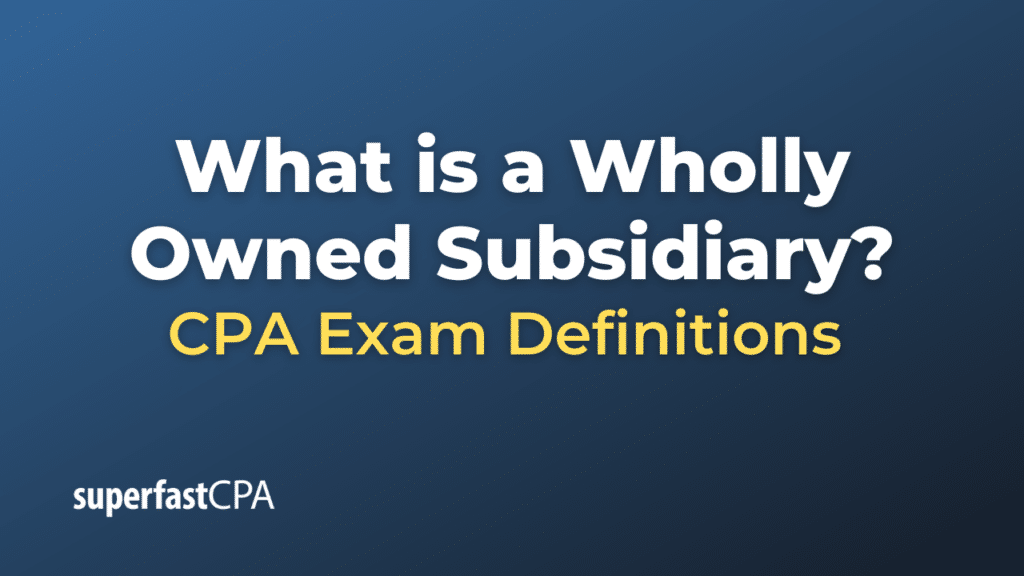Wholly Owned Subsidiary
A wholly-owned subsidiary is a company whose entire stock is owned by another company, known as the parent company. In such a setup, the parent company has full control over the subsidiary’s operations, decision-making, and profits. Because the subsidiary is 100% owned by the parent company, there are no minority shareholders in the subsidiary.
Characteristics of a Wholly Owned Subsidiary
- Control: The parent company has complete control over the subsidiary’s operations and strategic decisions.
- Independence: Despite being entirely owned, the subsidiary often operates as an independent legal entity, separate from the parent company. It can have its own organizational structure, assets, liabilities, and financial statements.
- Risk and Reward: The parent company absorbs all the risks but also reaps all the rewards from the subsidiary’s operations.
- Regulatory Compliance: The subsidiary is often responsible for its own regulatory compliance, including taxation, although some responsibilities might also fall on the parent company.
- Strategic Alignment: While the subsidiary has a level of operational independence, its strategic goals are usually aligned closely with those of the parent company.
Reasons for Creating a Wholly Owned Subsidiary
- Market Entry: Companies often establish wholly-owned subsidiaries in foreign countries as a means of entering a new market.
- Intellectual Property: To protect patents, trademarks, or copyrights, a parent company might place these assets in a wholly-owned subsidiary.
- Risk Isolation: By separating high-risk activities or assets into a wholly-owned subsidiary, a parent company can insulate itself from particular liabilities.
- Strategic Focus: Specialized activities or business units may be better managed as separate entities with a distinct focus.
- Tax Benefits: Depending on jurisdiction, there may be tax advantages to structuring business units as wholly-owned subsidiaries.
Example of a Wholly Owned Subsidiary
Let’s consider a fictional example to illustrate how a wholly-owned subsidiary might be utilized in a real-world scenario.
Example: TechGlobal and SecureSoft
Background
- TechGlobal Inc. is a multinational technology company that specializes in providing cloud computing solutions.
- SecureSoft LLC is a smaller company known for its cutting-edge cybersecurity software.
TechGlobal wants to enhance the security features of its cloud services to attract more customers from sectors like finance and healthcare that have stringent data protection requirements.
Acquisition and Subsidiary Formation
- To acquire this capability quickly, TechGlobal Inc. decides to buy SecureSoft LLC.
- After acquisition, SecureSoft becomes a wholly-owned subsidiary of TechGlobal Inc., now referred to as “SecureSoft, a TechGlobal Company.”
Post-Acquisition Operations
- Control and Independence: TechGlobal owns 100% of SecureSoft’s shares, giving it full control over the company. However, SecureSoft continues to operate as a separate legal entity with its own branding, management team, and organizational structure.
- Strategic Alignment: SecureSoft’s strategic goals and product development are now aligned with TechGlobal’s broader objectives.
- Financial Reporting: SecureSoft’s financials are consolidated into TechGlobal’s financial statements, but the subsidiary may still be required to file its own tax returns and financial reports depending on jurisdictional laws.
- Risk Isolation: Since SecureSoft operates in the specialized field of cybersecurity, any associated risks are isolated within the subsidiary rather than affecting the parent company directly.
- Benefit of Synergy: SecureSoft benefits from TechGlobal’s expansive customer base and marketing reach, while TechGlobal gains a competitive edge by offering enhanced security features in its cloud services.
Long-Term Strategy
TechGlobal Inc. eventually plans to fully integrate SecureSoft’s cybersecurity features into its own cloud services. In doing so, TechGlobal aims to position itself as the go-to provider for secure, scalable cloud solutions.
Why This Is a Wholly Owned Subsidiary
In this scenario, TechGlobal Inc. has complete ownership and control over SecureSoft, making it a wholly-owned subsidiary. This allows TechGlobal to reap all the benefits of SecureSoft’s specialized capabilities while integrating them into its broader service offering. It also allows for focused management and operational flexibility within SecureSoft, which can continue to innovate in its area of expertise.
By understanding the nature and potential benefits of a wholly-owned subsidiary, TechGlobal has strategically expanded its business portfolio and is better positioned to meet the evolving needs of its customers.













